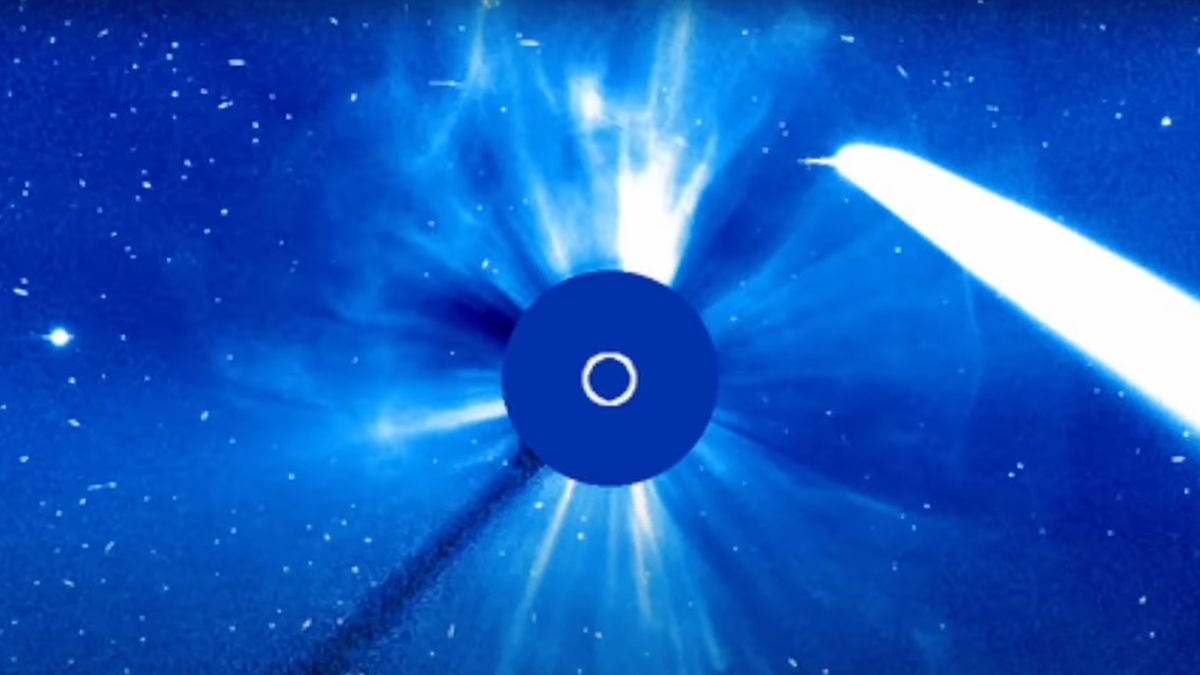11.10.2024
Comet Tsuchinshan-ATLAS is putting on a show in multiple ways.

The ESA-NASA SOHO spacecraft captured this view of Comet Tsuchinshan-ATLAS (bright white streak at right) during a solar eruption on Oct. 9, 2024. (Image credit: ESA/NASA/SOHO)
Nothing makes a photo more interesting than an unexpected guest appearing in the background. And how cool would it be if the photobomber were a comet?
That's exactly what happened to the sun-studying Solar and Heliospheric Observatory (SOHO) spacecraft, a joint effort of the European Space Agency (ESA) and NASA, beginning on Oct. 7.
Typically, scientists use the view from SOHO's Large Angle Spectrometric Coronagraph (LASCO) instrument to monitor the sun's activity and determine if a coronal mass ejection (CME) accompanies a solar flare from active sunspot regions. Coronographs block the overwhelmingly bright solar disk from view, allowing scientists to get a better look at solar activity that would otherwise be hidden by the sun's glare.
This week, a thick, bright line entered from the right side of SOHO's imagery and paraded across the field of view, moving toward the top of the frame. This vibrant white object was confirmed to be Comet C/2023 A3 (Tsuchinshan-ATLAS).
The comet's head, or coma, extends for roughly 130,000 miles (209,000 kilometers), with its tail measuring about 18 million miles (29 million km) long, which is why it has remained in SOHO's view for several days now. Being so close to Earth on its current track, Comet Tsuchinshan-ATLAS has been visible as well for stargazers across the United States and even to astronauts aboard the International Space Station (ISS)!
There's another treat in the new SOHO imagery as well: If you look to the left of the solar disk, you can see a bright white ball, which is the planet Mercury.
SOHO's imagery is recorded in real time, so we can see the beginning of Comet Tsuchinshan-ATLAS' "star-studded" appearance in LASCO's view. While the comet might be stealing the show as the brightest object in view, you can also see what look like puffs of smoke coming off the sun. Those are actually solar storms erupting from a sunspot and racing out into space. One of them was an X flare — the most powerful type of solar flare — and accompanying CME that erupted on Wednesday (Oct. 9) and were recorded by SOHO.
The confetti of white that spreads out across the view in the SOHO video is generated by charged solar particles hitting the camera, creating a "snow" effect across the imagery. You can check out the different views from SOHO at any time here.
If you're an amateur astronomer and are still hoping to get a glimpse of Comet Tsuchinshan-ATLAS, pending weather and sky conditions, look up approximately 25 minutes after the sun sets on Thursday (Oct. 10) and Friday (Oct. 11). You might need the assistance of binoculars to start to scan the horizon since the comet is at a lower altitude, but once you spot the vivid glow, there's a chance you might be able to see it with the naked eye. You can learn more about how to spot the comet in our Comet Tsuchinshan-ATLAS viewing guide.
Quelle: SC
